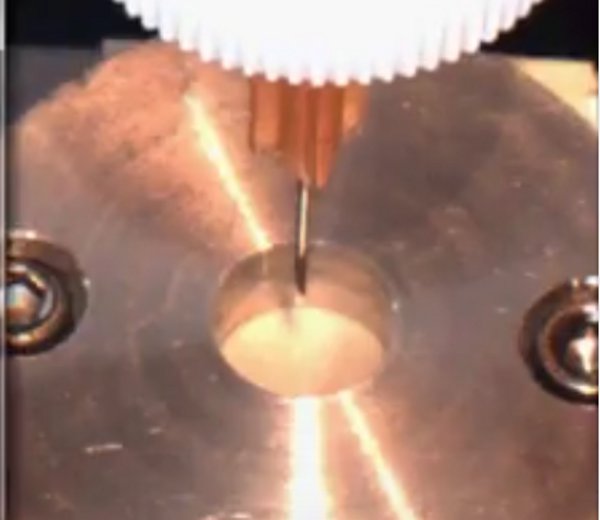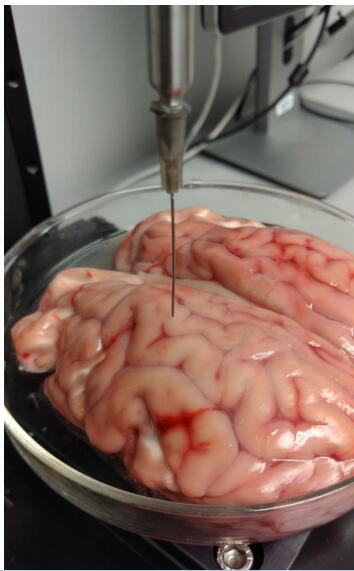详细介绍
多功能组织材料生物力学特性、电位分布测试分析表征系统
-之材料组织耐渗透性测试
耐渗透性测试涉及将探针(通常是针或圆锥形)插入材料中。 对于薄的柔性材料,耐渗透性是重要的终使用性能参考,其中锋利的产品会损坏包装材料。 各种参数会影响对渗透的响应,例如 膜厚,机械性能,穿透速度,探头尺寸和形状。

穿刺测试夹具MA735

该附件可正确夹持片状材料,以在渗透测试期间保持其笔直和水平。
针刺和摩擦测试

3D Normal Indentation Mapping
Mechanical indentation is a rapid and non-destructive assessment technique for biological tissues. Lately, Biomomentum has improved and augmented this technique with both mapping capability and solving...
Tension
The tension test is a fundamental test configuration in the field of material characterization. By pulling on both ends, the goal here is to evaluate how a sample will react to applied loading or displacement...
Unconfined Compression
The unconfined compression test is by far the most popular mechanical testing configuration to measure the mechanical properties of cylindrical-shaped samples. Sample with other geometry can also be tested...
Indentation (Stiffness)
An indentation test is a very convenient way to measure the mechanical properties of a sample non-destructively. Unlike the unconfined compression test, where a sample needs to be harvested from the surface,...
Friction
Friction tests determine the ease of two surfaces to slide against each other when subjected to a contact force. Two main phenomenons are generally observed during these tests: static and kinetic friction....
Bending
Bending (or flexure) tests characterize the behavior of a slender sample (one dimension being a small fraction - a tenth - of the other two) with load applied perpendicular to its longitudinal axis. This...
Torsion
Torsion refers to the twisting of a sample due to an applied torque. Various applications requires materials to withstand torsional stress. It is thus important to test this configuration since material...
3D Thickness Mapping
Using a needle probe under the load cell, it is also possible to map the surface profile and the thickness of a layer of material over a stiffer substrate (e.g. the cartilage layer over a bone). This is...
Shear
Shear tests can be used to evaluate the shear modulus G of a material in planar shear or in torsion. The shear modulus represents the stiffness of a material when a force is applied in a direction parallel...
Simultaneous Compression and Torsion
Simultaneous compression and torsion can be used to determine the mechanical behaviour of specific use samples. This is required in the case where samples primarily undergo complex loading. To accurately...
Dynamic Mechanical Analysis
Dynamic mechanical properties can be assessed from the response of a material subjected to a periodic stimulus which can be applied axially (tension/compression), or in shear (planar or torsion). These...
Burst
This test is generally conducted to verify the mechanical resistance of packaging material or packaging seals to internal pressurization. Using Biomomentum's tester, this package pressurization is achieved...
Puncture
Penetration resistance testing involves the insertion of a probe (often a needle or a cone) into a material. Penetration resistance is an important end-use performance reference for thin flexible materials,...
Tack (Adhesive)
It is quite easy to tell when a material is tacky or sticky simply by touching it and feeling how difficult it is to remove it from our fingers. The tackiness is the ability of a material to adhere instantaneously...
Fracture
A complete or partial fracture is the natural conclusion of applying progressively higher amounts of stress to a material. This point could also be referred to as failure. A fracture test is used to find...
Tear
Components often fail in service due to the generation and propagation of a special type of rupture called a tear. The tear test configuration measures the resistance to tearing action on a sample. Resistance...
Push-Out Test
This test configuration is used to evaluate the mechanical stability of a cylindrical plug (bone filler, osteochondral core, cartilage construct) after implantation. After sample preparation (normally...
Peeling (Stripping)
Peeling tests are employed to determine the strength of an adhesive bond between two materials. The peel strength is the average load per width unit required to separate that bond. Using its vertical axis,...
Impact
An impact test is used to quantify the resistance of a sample to high-rate loading. It is very useful in the safety study of product. For this test, an indenter is brought into contact with the sample...
Expression or Aspiration Force
Syringes are tested to quantify the force necessary to activate the plunger and express or aspirate fluid from, or to, the barrel (break-away force, glide force, etc). These forces depend on factors such...
Swelling and Contraction
Swelling and contraction of ionic gels can be induced by various factors such as pH, ionic concentration in the solution, ambient humidity, temperature, ongoing chemical reaction, etc. An easy way to study...
Lap Shear
Like the peel test, the lap shear is important for the mechanical characterization of adhesives. In this test configuration, two layers of material bonded together by an adhesive are forced to slide against...
Indentation (Hardness)
An indentation hardness test is a conventional method of measuring a solid material’s resistance to permanent damage after undergoing a compressive force. Using a very hard pointed indenter with known...
Confined Compression
Confined compression testing measures the capacity of a material to withstand axial compressive loads without expanding perpendicularly to the force. Confined compression tests are usually performed on...
Profilometry (3D)
Historically, profilometry was acknowledged as a graph of the surface height as the surface is moved relative to the contact profilometer's stylus (skating on the surface). This notion is changing with...
Profilometry (2D)
Historically, 2D profilometry was acknowledged as a graph of the surface height as the surface is moved relative to the contact profilometer's stylus (skating on the surface) over a line. This notion is...

Temperature Control
...
Cantilever Bending
Cantilever bending (or flexure) tests characterize the behavior of a long sample (one dimension being a small fraction - a tenth - of the other two). In this particular case, an external load is applied...
Mechanical Stimulation (Compressive)
The compressive stimulation of mechanically-responsive cell construct has been demonstrated to have important effects on the cell's activity, in particular, over the production of extracellular matrix...
Mechanical Stimulation (Tension)
The mechanical stimulation in tension of mechanically-responsive cell constructs has been demonstrated to have important effects on the cell's activity, in particular, over the production of extracellular...
Mechanical Stimulation (Shear)
The shear stimulation of mechanically-responsive cell constructs has been demonstrated to have important effects on the cell's activity, in particular, over the production of extracellular matrix components....
Electromechanical Measurement
Certain materials will provide an electrical response to a mechanical stimulus, for example piezoelectric crystals. Certain biomaterials (hydrogels) and tissues (articular cartilage) also show electromechanical...
Positioning (Manual Tilt)
This test configuration is normally coupled with other test configuration(s) to improve measurement when the surface of the sample is not flat. For example, when a disk sample (or core) has nonparallel...
Positioning (XY Auto)
This tester configuration allows a precise control of the horizontal position (XY directions) of sample or sample holder. For each stage, the control is performed through the Mach-1 Motion software (same...
Positioning (X Auto)
This test configuration allows precise and automated control of the horizontal position (X direction) of a sample or sample holder. The control is performed through the Mach-1 Motion software (same as...
Positioning (Manual)
The ability to precisely move the sample across the horizontal plane (under the compression axis) is a great advantage in various experimental configurations. Ideally, one will go for the mechanically-controlled...
Camera Feed
...
Digital Image Correlation (DIC)
Digital image correlation (DIC) is an optical method that uses tracking and image registration techniques for accurate 2D and 3D measurements of changes in a sample during deformation. This is often used...
 化工仪器网
化工仪器网





.svg)













.svg)




.svg)

.svg)
.svg)

.svg)
.svg)
.svg)


.svg)
.svg)
.svg)


 化工仪器网
化工仪器网